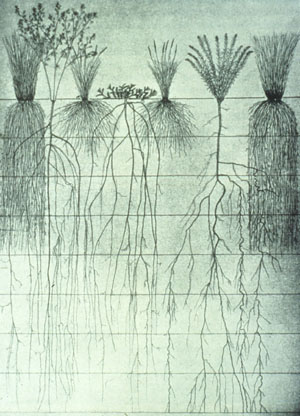What is a meadow?
In order to understand how to grow your own meadow, it is important to know what a meadow is. A natural wildflower meadow is loosely defined as an open space, free of trees and large shrubs where there is a natural ecosystem of wildflowers and native grasses growing intensively together. Naturally, meadows typically form after a disaster has occurred, clearing away existing trees, shrubs and other vegetation. These disasters include fire, flood, clear cutting, volcanic eruptions and glacial activity.
Man-Made Meadows
When we create wildflower meadows, we are basically fast-tracking the natural succession process by choosing to grow the species that are best suited to the specific site conditions of our properties. Man-made wildflower meadows create beautiful, sustainable landscapes that are designed by nature to thrive for many years with minimal maintenance. And wildflower meadows require no watering or fertilizing whatsoever.

Root Depth Chart
Each horizontal bar indicates 1 foot of depth! |
One of the secrets to success is planting intensively. Planting wildflowers and native grasses closely together eliminates weed competition once your meadow is mature as the dense, fibrous roots of the native grasses combine with the vertical taproots of the wildflowers to form an underground barrier that effectively prevents unwanted species or "weeds" from taking hold.
The image above shows these different types of root systems and how deep they can grow. By occupying different parts of the soil, these plants co-exist as a tight-knit plant community. In addition to the wonderful show of colourful flowers throughout the seasons, wildflower meadows provide soil stabilization, water filtration, as well as food and habitat for numerous species of insect and animal life who seek refuge from unpleasant weather conditions and predators.
The oldest man-made meadow grown from seed is located at the University of Wisconsin Arboretum, in Madison, Wisconsin. Beginning in 1935 crews from the Civilian Conservation Corps were stationed at the Arboretum and provided most of the labour needed to begin establishing what is now known as the Curtis Prairie. Efforts to restore or create historic ecological communities have continued over the years, with the result that the Arboretum's collection of restored ecosystems is not only the oldest but also the most extensive such collection in North America. If you ever get the chance to go to Madison in the summer, a visit to the Arboretum is a must!
|

